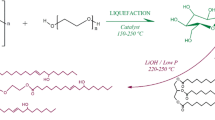Abstract
Natural and synthetic polymers are indispensable in today’s world. Recently, however, it has been found that most synthetic polymers developed from petroleum and coal are not compatible with the environment, since they cannot be included in the natural recycling system.
Access this chapter
Tax calculation will be finalised at checkout
Purchases are for personal use only
Preview
Unable to display preview. Download preview PDF.
Similar content being viewed by others
References
V. P. Saraf and W. G. Glasser, Engineering plastics from lignin. III. structure property relationship in solution cast polyurethane films, J. Appl. Polym. Sci. 29, 1831–1841 (1984).
V. P. Saraf W. G. Glasser, Engineering plastics from lignin. VI. structure property relationship of PEG-containing polyurethane networks, J. Appl. Polym. Sci. 30, 2207–2224 (1985).
H. Hatakeyama, S. Hirose, K. Nakamura, and T. Hatakeyama, in: Cellulosics: Chemical, Biochemical and Material Aspects, edited by J. F. Kennedy, G. O. Phillips and P. A. Williams (Ellis Horwood, Chichester, 1993), pp. 524–536.
N. Morohoshi, S. Hirose, H. Hatakeyama, T. Tokashiki, and K. Teruya, Biodegradability of polyurethane foams derived from molasses, Sen-i Gakkaishi 51, 143–149 (1995).
H. Hatakeyama, S. Hirose, T. Hatakeyama, K. Nakamura, K. Kobashigawa, and N. Morohoshi, Biodegradable polyurethanes from plant components, J. Macromol. Sci. Pure Appl. Chem. A32, 743–750 (1995).
M. J. Donnely, Polyurethanes from renewable resources. IV-properties of linear, crosslinked and segmented polymers from polytetrahydrofuran diols and their glucosides, Polym. Int. 37, 297–314 (1995).
K. Nakamura, Y. Nishimura, P. Zetterlund, T. Hatakeyama, and H. Hatakeyama, TG-FTIR studies on biodegradable polyurethanes containing mono-and disaccharide components, Thermochmica Acta 282/283, 433–441 (1996).
P. Zetterlund, S. Hirose, T. Hatakeyama, H. Hatakeyama, and A.-C. Albertsson, Thermal and mechanical properties of polyurethanes derived from mono-and disaccharides, Polym. Int. 42, 1–8 (1997).
H. Hatakeyama, K. Kobashigawa, S. Hirose, and T. Hatakeyama, Synthesis and physical properties of polyurethanes from saccharide-based polycaprolactones, Macromol. Symp. 130, 127–138 (1998).
T. Hatakeyama, T. Tokashiki, and H. Hatakeyama, Thermal properties of polyurethanes derived from molasses before and after biodegradation, MacromoL Symp. 130, 139–150 (1998).
T. Hatakeyama and F. X. Quinn, in: Thermal Analysis (John Wiley & Sons, Chichester, 1994).
K. Nakamura, T. Hatakeyama, and H. Hatakeyama, Thermal properties of solvolysis lignin-derived polyurethanes, Polym. Adv. Technol 3, 151–155 (1992).
H. Hatakeyama, K. Nakamura, and T. Hatakeyama, Studies on factors affecting the molecular motion of lignin and lignin-related polystyrene derivatives, Pulp Paper Mag. Can. 6, TR 105–110 (1980).
T. Hatakeyama, K. Nakamura, and H. Hatakeyama, Studies on heat capacity of cellulose and lignin, Polymer 23, 1801–1804 (1982).
J. Nakano, Y. Izuta, T. Orita, H. Hatakeyama, K. kobashigawa, K. Teruya, and S. Hirose, Thermal and mechanical properties of polyurethanes derived from Fractionated Kraft lignin, Sen-i Gakkaishi 50, 416–422 (1997).
T. Hatakeyama and H. Hatakeyama, Effect of chemical structure of amorphous polymers on heat capacity difference at glass transition temperature, Thermochim. Acta 267, 249 (1995).
S. Hirose, K. Kobashigawa, Y. Izuta, and H. Hatakeyama, Thermal degradation of polyurethanes containing lignin studied by TG-FTIR, Polym. Int. 47, 247–256 (1998).
J. H. Saunders and K.C. Fisch, in: Polyurethanes, Chemistry and Technology in High Polymers, Vol. XV (Interscience Publishers, New York, 1962), pp.103.
Author information
Authors and Affiliations
Editor information
Editors and Affiliations
Rights and permissions
Copyright information
© 2002 Springer Science+Business Media New York
About this chapter
Cite this chapter
Hatakeyama, H. (2002). Polyurethanes Containing Lignin. In: Hu, T.Q. (eds) Chemical Modification, Properties, and Usage of Lignin. Springer, Boston, MA. https://doi.org/10.1007/978-1-4615-0643-0_3
Download citation
DOI: https://doi.org/10.1007/978-1-4615-0643-0_3
Publisher Name: Springer, Boston, MA
Print ISBN: 978-1-4613-5173-3
Online ISBN: 978-1-4615-0643-0
eBook Packages: Springer Book Archive




